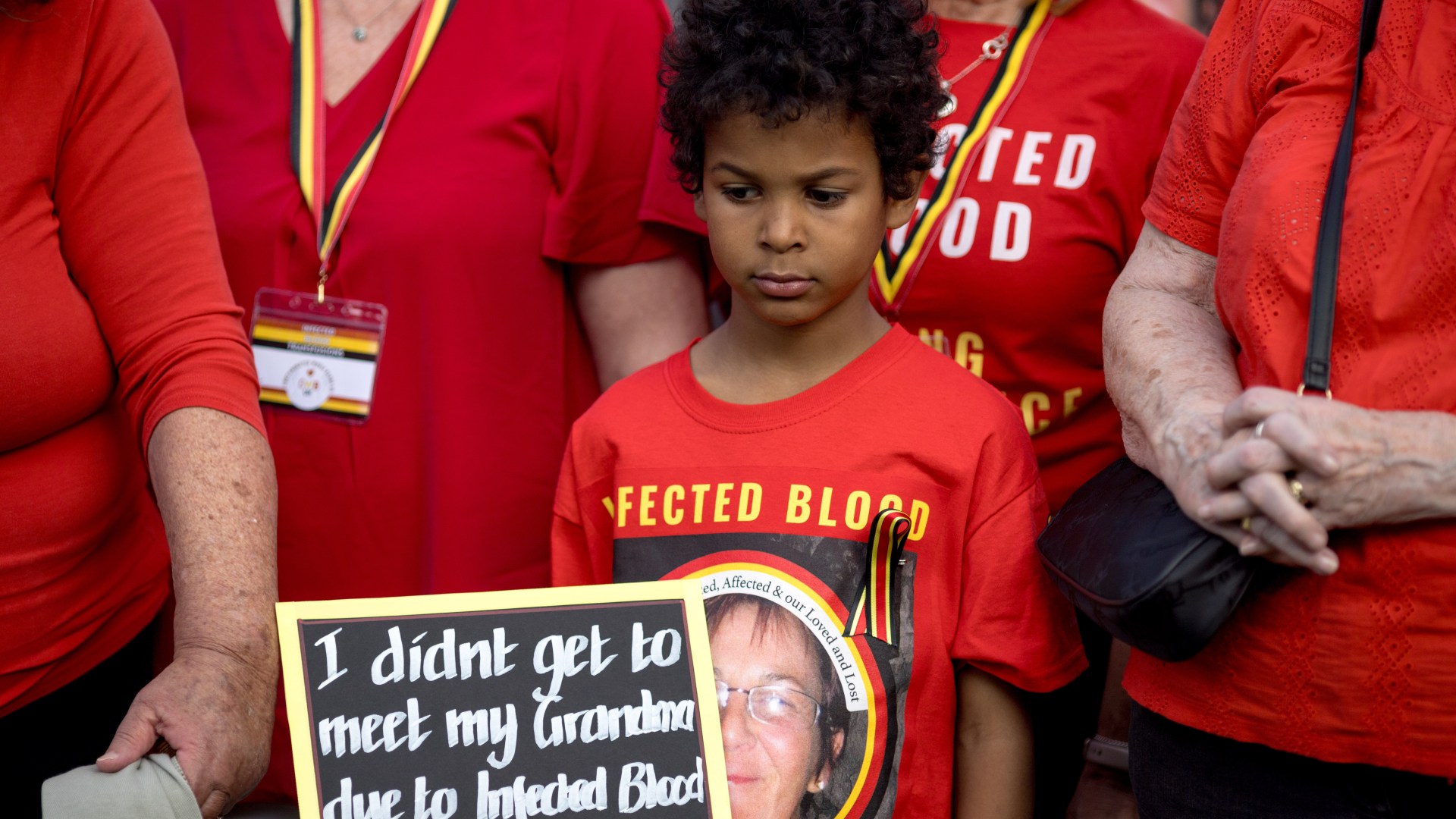
POLITICIANS, doctors and the NHS conducted a “subtle, pervasive and chilling” cover-up of the “worst ever” health scandal which saw more than 30,000 people infected with incurable blood diseases, a landmark inquiry has ruled.
They lied for years about the risks of taking blood from prisoners and drug addicts as patients were killed or struck down by HIV and hepatitis due to medical blunders.
12

12

12

12
More than 3,000 people have died after being infected with HIV and hepatitis C in the 1970s and 1980s after receiving transfusions or blood products from the NHS.
This afternoon, Rishi Sunak will apologise to the thousands of victims of the scandal, which the Infected Blood Inquiry has found could and should have been avoided.
In a damning seven-volume investigation into what happened, Chair of the Inquiry Sir Brian Langstaff concludes that those in positions of power in Government and the health service deliberately misled the public.
Patients with blood disorders like haemophilia were given treatments made from the blood of prisoners and drug addicts for years after experts realised it was dangerous.
Convicts in the US were given cash to donate but had high rates of deadly hepatitis C and HIV, with just a fraction of a millilitre of blood enough to infect someone.
Gung-ho doctors in Britain brushed the risks under the carpet and did not tell patients about them, lied to them, or even injected them without telling them.
Many of the victims were children who later died of AIDS in their teens or young adulthood.
Hundreds of survivors have suffered with trauma for decades and turned to drink, drugs and even suicide attempts.
A 2,500-page final report into the disaster has found that the evidence that the truth of what happened was “concealed or suppressed” is “overwhelming”.
Condemning the indecision by successive leaders, Sir Brian said: “Whilst the Government deliberated, those infected with AIDS through transfusion were suffering and dying.”
There was a “defensive closing of ranks” in the NHS after it came to light that patients being treated for haemophilia and other disorders were actually being infected with HIV and hepatitis through transfusions from 1970 onwards.
The father of a boy who was infected with hepatitis C said: “The NHS should have been much more open about what was happening from the beginning.
“It felt like a closed shop right from the start, no one knew what was going on and there was no information out there.
“There was nobody willing to take any responsibility for what had happened and that’s not right.”
In a key finding, Sir Brian states that the delay in a Government response to what was happening only increased the suffering dealt to victims and their families.
A pervasive attitude of “doctor knows best” meant that the Department of Health repeatedly chose not to issue guidance to stop the unsafe use of infected blood.
There was a “slow and inadequate response to taking precautions” even when “the writing was on the wall”.
The Inquiry also found that the blood services themselves were “slow to react” to the threat of AIDS” and did “too little, too late”.
What is the infected blood scandal?
THE contaminated blood scandal has been described as one of the worst in NHS history and stems from blood transfusions and blood-derived medicines used in the 1970s and 1980s.
These medical products were injected into patients, often children, who had blood disorders like haemophilia, which stops clotting and can cause severe bleeding.
Unlike regular blood donations, plasma products such as Factor VIII were often sourced from the United States and elsewhere and, as donors there could be paid to give blood, some donations came from high-risk people such as prostitutes and prisoners who are more likely to have blood diseases.
Tens of thousands of donations were mixed together for a single batch in some cases, but it only took one infected donor to contaminate an entire batch and infect patients.
At the time, the NHS had stopped paying donors for whole blood donations to reduce the risk but we could not make enough in Britain so they had to be imported.
As patients began to fall ill it was later discovered that thousands had been infected with HIV and hepatitis by the blood of poorly tested donors.
More than 2,900 people have died as a result of the scandal and tens of thousands are believed to have been directly infected or caught a virus from a relative or partner.
Campaigners say doctors and politicians ignored warnings about what would happen and then covered up their failings when patients began to fall ill.
Survivors and their families were entitled to £100,000 each in compensation in 2022 and more is expected after the publication of the full inquiry on May 20, 2024.
Government fear of setting a precedent for compensation schemes “outweighed considerations of moral responsibility or compassion”, the Inquiry found.
Officials had decided at the outset not to provide compensation to victims of the scandal with thousands of people dying without receiving a penny.
There was a cover-up of what had happened to thousands of men, women and children “not in the sense of a handful of people plotting in an orchestrated conspiracy to mislead”, but in a “subtle, more pervasive and more chilling” way.
The report states: “In this way there has been a hiding of much of the truth.
“The people most directly affected said there was more to what happened than was in the public domain and they were correct.
“And yet it has taken decades to get an authoritative account of what happened to cause so many deaths, prolonged and wasting illnesses, and infections: and it is still not a full account since so many key witnesses have died and documents have been lost.”
Lives, dreams, friendships, families, and finances were destroyed. This disaster was not an accident
Sir Brian Langstaff
It continues: “A lack of openness, a lack of inquiry, a lack of accountability and elements of downright deception have led to a lack of trust in those responsible for the treatment – that is, their treatment both medically and as citizens of a democratic state – and this has in turn done further damage to them.”
In the 1980s and 1990s, politicians consistently insisted that the best treatment had been given to patients given the medical expertise that was held at the time.
Sir Brian concludes that this assertion was “wrong” and led to a “blindness” by politicians to what had actually happened.
He wrote: “It was a statement of perfection – asserting that there was nothing better that could have been done.
“The use of such a statement should always be approached with considerable caution.
“There was no recognition of anything that might balance the absolutist claim that the treatment was simply the best.”

12

12

12

12
In November 1989, at a meeting at Downing Street, then-Prime Minister Margaret Thatcher had stated that “the position was” that people infected with HIV from blood products “had been given the best treatment available on the then current medical advice, and without it many of the haemophiliacs would have died.”
This is the line which was taken when resisting calls for compensation to be paid to the victims of the treatment scandal.
The “best available treatment” line did not change when Tony Blair’s Labour Government came to power in 1997 – and continued to be used until 2009.
The Inquiry has also found that documents which should have been “accessible and recoverable” were deliberately destroyed by Government departments.
Three sets of documents are missing – either having been lost or destroyed – in “a deliberate attempt to make the truth more difficult to reveal”.
Sir Brian said: “In families across the UK, people were treated by the NHS and over 30,000 were given infections which were life shattering.
“3,000 people have already died and that number is climbing week by week. Lives, dreams, friendships, families, finances were destroyed.
“This disaster was not an accident. The infections happened because those in authority – doctors, the blood services and successive governments – did not put patient safety first.
“The response of those in authority served to compound people’s suffering.
“The government is right to accept that compensation must be paid.
“Now is the time for national recognition of this disaster and for proper compensation to all who have been wronged.”
‘Shocking lack of compassion and humanity’
Those affected are expected to receive compensation up to £10billion.
Responding to the findings, Kate Burt, chief executive of the Haemophilia Society, said: “This report vindicates the long-held beliefs of survivors that the government hid the truth to protect itself and to save money.
“The tragic truth is that many of the infections could and should have been prevented.
“The state and NHS bodies failed to protect peoples’ lives. A generation of people with haemophilia and other bleeding disorders were decimated by the infections they received through contaminated blood products.
“Patients were treated without their consent; that was unethical and wrong.
“The report highlights a shocking lack of compassion and humanity which should shame government, civil servants and the NHS.
“People with haemophilia and their families received terrifying terminal diagnoses without support, without hope.
“For decades, they and their families have endured prejudice, discrimination and cruelty as they faced what they believed was certain death from HIV and hepatitis C contracted through their NHS treatment.
“The scale of human suffering unleashed by this scandal, and deepened by decades of government denial and inaction, is a national disgrace.”

12

12

12

12
The infected blood scandal in numbers

IT’S thought that tens of thousands of people in the UK were infected with contaminated blood between the 1970s and early 1990s.
Statisticians advising the Infected Blood Inquiry have come up with a number of different figures about how many people have been infected, but they have stressed there is “considerable uncertainty about the conclusions”.
Commentators have suggested that the figures – particularly those around hepatitis C infections – should be seen as a “starting point”.
According to the inquiry’s Statistics Expert Group:
- Around 1,250 people with bleeding disorders such as haemophilia were infected with HIV through infected blood products.
- Some 80 to 100 people were infected with HIV as a result of a blood transfusion – which could have been given following an accident, during surgery, during childbirth or another medical procedure.
- Between 3,650 and 6,250 people with bleeding disorders were infected with hepatitis C – this includes 1,250 people who were infected with both HIV and hepatitis C.
- Some 26,800 people were infected with hepatitis C as a result of having a blood transfusion – though statisticians said this number could vary anywhere between 21,300 and 38,800 people.
- Some 22,000 of these were deemed to be chronically infected as they survived more than six months after their transfusion.
- Among people who received hepatitis C as a result of a blood transfusion, 64 per cent were women.
- Of the 26,800 hepatitis C infections which occurred as a result of a blood transfusion, 22,000 were among patients in England, 2,740 occurred in Scotland, 1,320 in Wales, and 730 patients were infected in Northern Ireland.
- Five people were infected with variant Creutzfeldt-Jakob disease, causing brain damage. They all died.
- The figures do not include people who were “indirectly infected” – such as a partner who caught HIV from a loved one who had been given contaminated blood or a blood product.
- Statisticians said that it is not possible to estimate the numbers of hepatitis B virus infections with “reasonable accuracy”.
It’s been estimated that 3,000 people have died as a result of the infections, while others live with ongoing side effects of infection.
Source: PA







